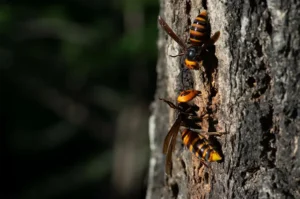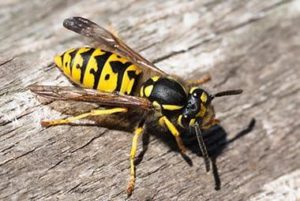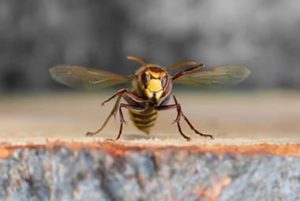The summer is half gone, and as the season passes, behavioral patterns for the insects around us begin to change. Around this time of year, Russell’s Pest Control begins to get many phone calls about bees and wasps, particularly yellow jackets. Since you could be encountering these creatures much more often over the next few weeks, let’s have a look at yellow jackets and why they cause such trouble for people in East Tennessee.
Although they have the black and yellow stripes that we associate with the generic term “bees,” yellow jackets are, in fact, wasps (which makes them cousins to bees). We’ve covered some solitary members of this family before (cicada killers and carpenter bees), but yellow jackets live most of their lives in large groups.
A yellow jacket nest is started by a single pregnant queen at the beginning of spring. She emerges from hibernation and begins to build a nest for her future colony. Yellow jackets aren’t overly selective about their nest location. You can find their large hives hung from a tree branch, connected to the roof of a building, or tucked neatly underground with a tunnel leading out to the lawn. The queen’s nest is made up of perfectly symmetrical, regular hexagons, which she fills with eggs as quickly as she can so that she can get help building the remainder of the nest. In a short time, she’ll have all the help she needs. That single queen can lay about 25,000 eggs!
What’s interesting about yellow jackets is their feeding habits. The adults need sugars to survive, so you will find them sipping nectar like any friendly honey bee. However, the larvae need protein to survive, which sometimes earns them the nickname “meat bee.” These wasps will not apologize for getting the food that they need. They are aggressive foragers, and, in the spring, you are likely to find them landing on your cheeseburgers and hotdogs and leaving with chunks of food for their young. Actually, yellow jackets are also serving as pest control experts during this time; they willingly hunt other pests and feed them to their larvae. As the year progresses, the adult yellow jacket population increases, which means more sugars are necessary to sustain them. That’s when you find them buzzing around your desserts or even inside your soda can (yikes!).
People tend to have bad experiences with yellow jackets for one of two reasons. In the first case, people are likely to get stung if they flail and swat at yellow jackets that are foraging for food. These aggressive wasps will not hesitate to sting if they feel threatened, and people who panic increase their risk of a yellow jacket attack. In the second case, people run the risk of being stung if they block the flight path of yellow jackets trying to return to their underground nest. Most of the insects in this family have about a ten-foot flight pattern that they always use to return home. If a person invades that airspace, the yellow jackets could descend as a group to try to clear away any threat to their nest.
You should know that these creatures function like pack animals; if one yellow jacket attacks you, many more are likely to come to their companion’s aid. Unfortunately, they also have a nasty habit of pursuing their victims, so it’s best to put a lot of distance between you and the contested space if you find you’ve been stung.
We like to give good advice for readers who may want to handle a pest problem without calling a professional like Russell’s Pest Control. However, be warned that you should only deal with yellow jackets with the proper protective equipment, and you do so at your own risk. Although a yellow jacket sting may only result in localized pain and swelling that lasts for a day or two, anyone allergic to their stings can experience very serious and even life-threatening reactions.
If you are able to locate an above ground nest, you can try something as simple as knocking it down. Do this only while wearing a proper bee suit, and try to approach the nest in the evening when the wasps are more docile. Additionally, there are traps available for yellow jackets; these are most effective early in the year when you’re more likely to eliminate a larger percentage of the nest’s adult population. There are also insecticide bait stations that allow the wasps to take “food” back to the colony, and the food kills the larvae before they have a chance to develop. Even over-the-counter versions of those baits can be quite pricey, and you may be better off contacting a professional like Russell’s Pest Control for a free inspection before you spend money on a product like that. As always, you can give us a call or contact us online.
Yellow Jackets Are A Summer Problem in Knoxville TN
Serving East Tennessee since 1971


